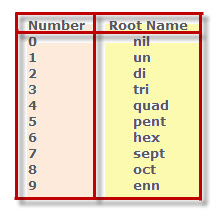Synthetic elements are man-made. These elements are radioactive (decay giving off radiation).
Synthetic elements are often named after the person discovering them or after some famous scientist, such as Einsteinium. The person who is given credit for discovering an element has the right to name it.
Both Soviet and American scientists claimed to have been the first to discover elements 104 and 105. The American name for element 104 was to be rutherfordium, and the Soviet name for the same element was kurchatovium. Due to this conflict over who was first to discover elements 104 and 105, temporary names were needed.
An international chemistry organization came up with a system for temporary names of new elements. Using this system, an element’s number is used as its temporary name. Since the number of new elements has three digits, the names are made of three root names for each digit in the number plus an ending of ium. For example, using the names in the Root Name table, the name of element 104 is:
1 + 0 + 4 + ium = unnilquadium
un + nil + quad + ium = unnilquadium
The symbol for element 104 is the first letter of each root name, which is Unq (un + nil + quad). As with the symbol of all elements, the first letter is capital and the other letters are lowercase. Even though an element with a number of 140 has not been discovered as yet, scientist can give this yet to be discovered element the temporary name of unquadnilium (Uqn).
 The names for elements 101 through 110 are now known as:
The names for elements 101 through 110 are now known as:
101 (Mendelevium, Md )
102 (Nobelium, No )
103 (Lawrencium, Lr )
104 (Rutherfordium Rf)
105 (Dubnium Db)
106 (Seaborgium Sg)
107 (Bohrium Bh)
108 (Hassium Hs)
109 (Meitnerium Mt)
110 (Darmstadtium Ds).